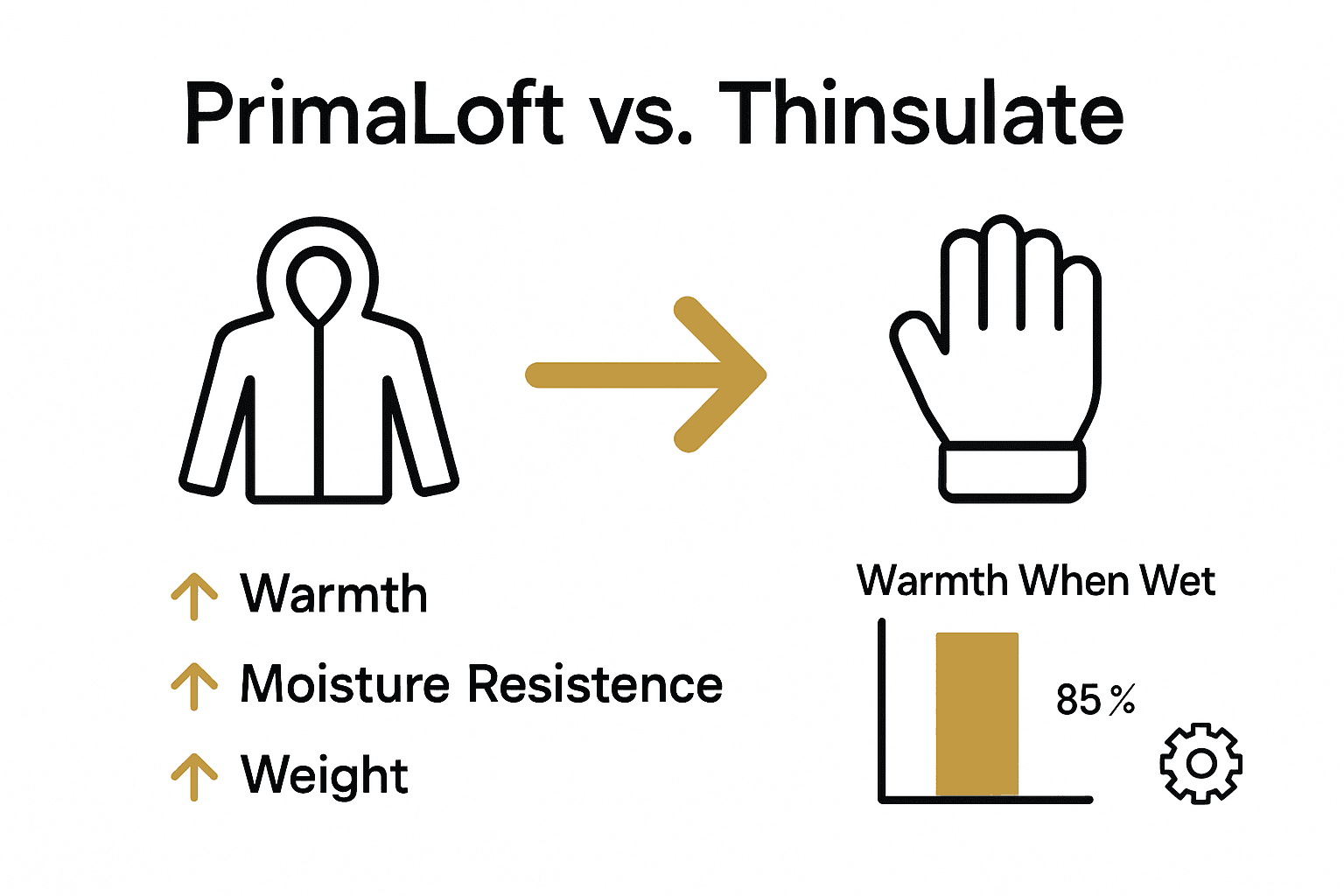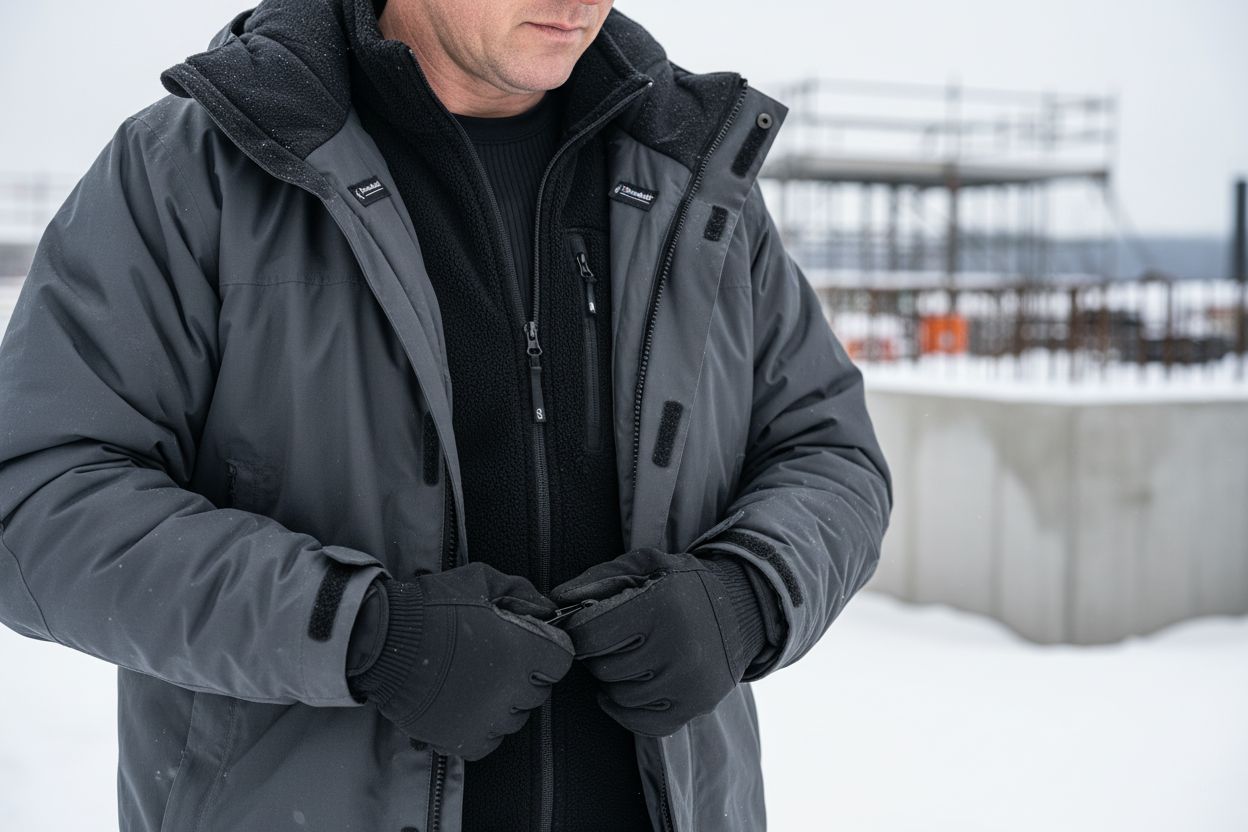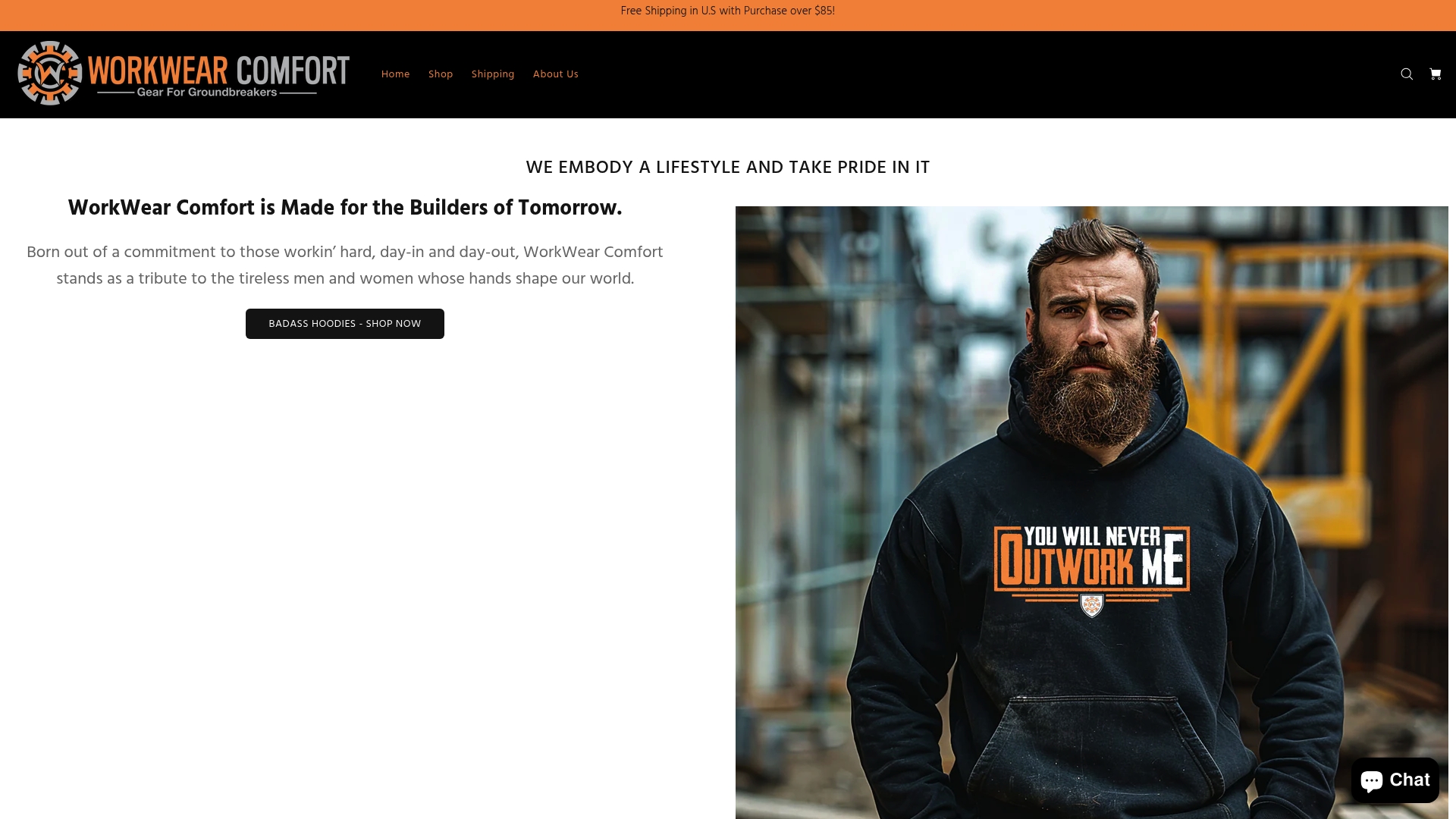Did you know that exposure to extreme cold can cause work productivity to drop by almost 30 percent, according to health and safety experts? Choosing the right men’s winter workwear is about more than just staying warm. Selecting proper gear means workers stay safe, comfortable, and ready to tackle any challenge, no matter how brutal the weather. Top-performing winter workwear includes advanced materials and strategic layering, giving workers the protection they need from harsh conditions.
Key Takeaways
| Point | Details |
|---|---|
| Three-Layer Approach | Effective winter workwear consists of a moisture-wicking base layer, an insulating middle layer, and a wind and water-resistant outer layer to ensure optimal protection against cold conditions. |
| Material Quality | Invest in high-quality synthetic insulations like PrimaLoft and Thinsulate for superior warmth and moisture resistance, enhancing on-the-job performance. |
| Safety Features | Essential attributes include high-visibility elements and properly fitting garments to prevent accidents and ensure adequate circulation in extreme weather. |
| Strategic Spending | Avoid common pitfalls by selecting versatile, durable pieces and buying during off-season sales to maximize the value of winter workwear investments. |
Table of Contents
- Defining Men’s Winter Workwear Basics
- Key Materials And Insulation Technologies
- Essential Layers For Winter Job Sites
- Critical Safety And Weatherproof Features
- Choosing Styles For Blue-Collar Professions
- Common Mistakes And Cost-Saving Tips
Defining Men’s Winter Workwear Basics
When temperatures drop and job sites become freezing landscapes, understanding winter workwear isn’t just about comfort—it’s about survival and safety. Winter workwear represents more than clothing; it’s your professional armor against harsh environmental conditions.
According to OSHA’s winter preparedness guidelines, proper winter workwear is critical for preventing cold stress and maintaining worker safety. The fundamental strategy involves a three-layer approach:
- Inner Layer: Moisture-wicking materials that pull sweat away from skin
- Middle Layer: Insulating materials like fleece or wool that trap body heat
- Outer Layer: Wind and water-resistant shells that protect against external elements
OSHA recommends that workers dress in loose-fitting clothing, which allows better air circulation and temperature regulation. This means selecting garments that provide flexibility without compromising warmth. Key accessories like insulated gloves, thermal socks, and protective headwear are not optional—they’re essential for maintaining core body temperature in challenging work environments.
Winter workwear isn’t one-size-fits-all. Different trades—from construction to agriculture—require specialized clothing that balances protection, mobility, and durability. The right gear can mean the difference between a productive workday and a potentially dangerous cold-related incident. Safety starts with what you wear.
Key Materials and Insulation Technologies
Workwear insulation has evolved dramatically from basic wool layers to sophisticated thermal technologies designed for extreme conditions. Understanding these advanced materials can mean the difference between comfort and cold-induced productivity loss.
Synthetic Insulations have revolutionized winter workwear, with two standout technologies leading the pack. PrimaLoft, originally developed for the U.S. Army, represents a breakthrough in microfiber insulation. According to research, it retains an impressive 96% of its insulating capability even when wet—a critical feature for outdoor workers facing unpredictable environments.
Another game-changing material is Thinsulate, produced by 3M. Its unique properties provide remarkable thermal efficiency:

- Delivers 1½ times the warmth of traditional down at equivalent thickness
- Maintains insulating properties in damp conditions
- Offers lightweight protection without bulk
- Ideal for workers requiring maximum mobility and warmth
Beyond synthetic innovations, modern workwear combines multiple material technologies to create comprehensive thermal protection. Read our guide on understanding warm work jackets to dive deeper into how these advanced materials are integrated into professional-grade clothing. The goal is always the same: keeping workers warm, dry, and ready to tackle challenging work environments with confidence and comfort.

Essential Layers for Winter Job Sites
Layering is the cornerstone of effective winter workwear, transforming your clothing from a simple outfit into a strategic thermal defense system. When job sites become cold battlegrounds, your clothing needs to work as hard as you do.
Here’s a summary of the recommended winter workwear layers and their key functions:
| Layer | Main Function | Typical Materials |
|---|---|---|
| Base Layer | Moisture wicking | Wool Silk Synthetics |
| Middle Layer | Insulation Heat retention |
Fleece Wool Synthetic fill |
| Outer Layer | Wind & water protection | Waterproof shell Windproof fabric |
OSHA’s cold stress guidelines provide a critical blueprint for winter protection, recommending a three-layer approach that’s both scientific and practical. Here’s how to build your winter work armor:
- Base Layer: Moisture-wicking materials
- Typically made from wool, silk, or synthetic fabrics
- Pulls sweat away from skin to prevent rapid heat loss
- Keeps your body dry and maintains core temperature
- Middle Layer: Insulating materials
- Wool, fleece, or synthetic insulators
- Traps warm air close to your body
- Creates a thermal barrier against cold
- Outer Layer: Wind and water protection
- Windproof and waterproof shells
- Blocks external moisture and wind
- Allows moisture from inner layers to escape
NIOSH research emphasizes protecting vulnerable extremities—ears, face, hands, and feet. Pro tip: Always carry extra socks, gloves, and a backup hat. Waterproof, insulated boots aren’t just recommended; they’re your first line of defense against cold-induced productivity loss.
Smart layering isn’t just about warmth—it’s about maintaining your performance in the toughest conditions.
Critical Safety and Weatherproof Features
Safety in winter workwear isn’t just about staying warm—it’s about protecting yourself from environmental hazards that can compromise your health and job performance. Weatherproofing transforms ordinary clothing into a critical shield against potentially dangerous work conditions.
OSHA’s winter safety guidelines emphasize crucial protective features that go beyond basic thermal comfort. Key safety considerations include:
-
High-Visibility Elements
- Essential in traffic and hazard-prone zones
- Increases worker detection in low-light conditions
- Reduces risk of accidents on job sites
-
Footwear Specifications
- Insulated and water-resistant boots
- Superior tread design for ice and snow traction
- Prevents slips and falls in treacherous conditions
Garment fit is another critical safety factor. OSHA warns that tight clothing can dangerously restrict blood circulation, increasing the risk of cold-related injuries. The solution? Loose-fitting layers that allow air circulation while maintaining thermal protection. Outer layers must be wind and waterproof, creating a robust barrier against moisture and wind chill.
Pro Tip: Think of your winter workwear as personal protective equipment. Every feature—from reflective strips to reinforced seams—is designed to keep you safe, warm, and performing at your best. Check out our guide on understanding construction gear to dive deeper into professional-grade winter protection strategies.
Choosing Styles for Blue-Collar Professions
Workwear style isn’t just about looking good—it’s about functionality, durability, and representing the professional pride inherent in blue-collar trades. Each profession demands unique clothing characteristics that go far beyond basic fashion considerations.
Construction workers, welders, and mechanics require clothing that can withstand extreme conditions while providing maximum mobility and protection. Key style considerations include:
-
Durability Factors
- Reinforced stress points
- Heavy-duty fabric materials
- Triple-stitched seams
- Ripstop fabrics
-
Professional Considerations
- Color-coded uniforms for different trades
- Integrated tool loops and pockets
- Flame-resistant options for high-risk environments
- Reflective safety elements
Fit is crucial. Loose enough for movement, but not so baggy that they become a safety hazard. Learn more about understanding the blue-collar dress code to see how professional appearance intersects with practical requirements.
Beyond physical demands, workwear represents a cultural identity. It’s a visual language that communicates skill, experience, and professional commitment. Whether you’re a plumber, electrician, or agricultural worker, your clothing tells a story of resilience, craftsmanship, and pride in your trade. Choose wisely—your workwear is more than fabric. It’s your professional armor.
Common Mistakes and Cost-Saving Tips
Winter workwear investments can quickly become expensive, but smart workers know how to maximize value without compromising safety or comfort. The most common mistake is viewing workwear as a simple expense rather than a critical professional investment.
Top mistakes blue-collar professionals frequently make include:
-
Purchasing Incorrectly
- Buying based on price alone
- Ignoring specific job-site requirements
- Neglecting material durability
- Skipping proper sizing
-
Cost-Saving Strategies
- Buy versatile pieces that work across multiple environments
- Invest in high-quality base layers
- Purchase during off-season sales
- Consider modular clothing systems
Layer strategically to extend your clothing’s usefulness. A high-quality base layer paired with interchangeable mid and outer layers can dramatically reduce overall clothing costs. Explore our guide on understanding workwear fundamentals to make more informed purchasing decisions.
Remember: Cheap isn’t always economical. A $30 jacket that falls apart after two months costs more long-term than a $150 jacket lasting three years. Invest wisely in your professional armor—your productivity, safety, and wallet will thank you.
Discover Workwear That Works as Hard as You Do This Winter
Built for blue-collar workers who face the toughest winter demands, our apparel is designed to tackle every pain point covered in the guide. If you have ever struggled to find sweatshirts that protect you from biting cold, maintain flexibility, or withstand daily wear and tear, Blue-Collar Working Man Sweatshirt Hoodies are engineered just for you. Tackle the chill with confidence and benefit from strategic layering without sacrificing comfort or safety so you can focus on the job, not your gear.

Why settle for less when you can invest in workwear that values your skill and resilience? Explore the full collection at WorkwearComfort.com for rugged sweatshirts and more options that align with the values of hardworking professionals. Get ready to handle winter’s worst. Shop now and start building your ultimate cold-weather defense today.
Frequently Asked Questions
What are the essential layers in men’s winter workwear?
The essential layers include a base layer for moisture-wicking, a middle layer for insulation, and an outer layer for wind and water protection. This three-layer system helps maintain temperature and comfort while working in cold conditions.
What materials are recommended for the inner and outer layers of winter workwear?
For the inner layer, moisture-wicking materials like wool, silk, or synthetics are recommended. The outer layer should consist of windproof and waterproof shells that block moisture and wind, allowing inner moisture to escape.
How can I enhance safety with winter workwear?
Enhancing safety can be achieved through high-visibility elements, insulated, water-resistant footwear, and ensuring a proper fit. Loose-fitting layers aid in circulation and reduce the risk of cold-related injuries.
What are the common mistakes to avoid when purchasing winter workwear?
Common mistakes include purchasing based solely on price, ignoring specific job-site requirements, neglecting material durability, and selecting improper sizing. It’s important to consider quality and functionality over cost to ensure safety and comfort.


